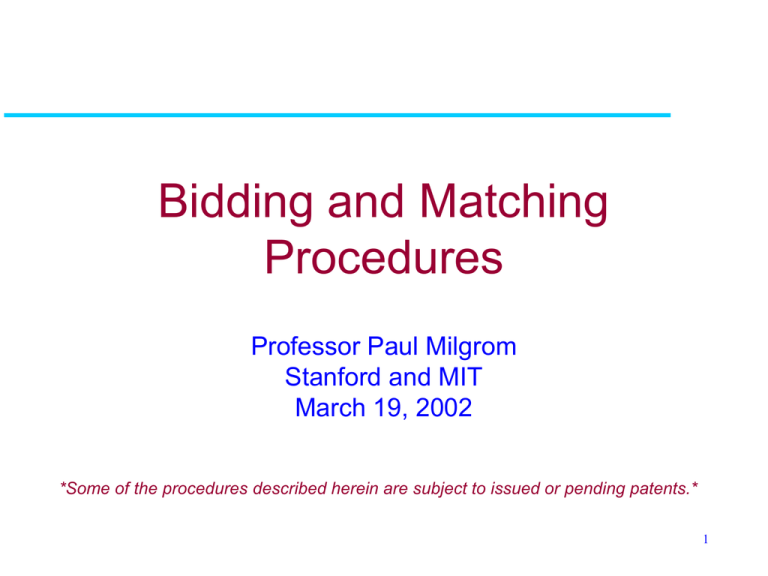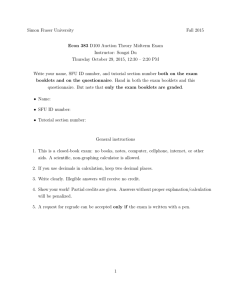Bidding and Matching Procedures Professor Paul Milgrom Stanford and MIT
advertisement

Bidding and Matching Procedures Professor Paul Milgrom Stanford and MIT March 19, 2002 *Some of the procedures described herein are subject to issued or pending patents.* 1 Some Recent Market Designs Innovations involving… – Multi-item, multi-round, mostly monotonic procedures Auction procedures – – – – Radio spectrum ($) Asset sales ($) Electrical power ($, term) CO2 emissions reductions (tons of pollutants) Matching procedures – Redesign of the National Resident Matching Program 2 Outline Bids including cash – FCC spectrum auctions (cash only) – Electricité de France power auctions (cash & terms) Non-cash bids only – British CO2 auctions (emissions reductions) – National Resident Matching Program Package procedures – FCC Auction #31 – Redesigned NRMP 3 FCC Spectrum Auctions Auction No. Auction Name 1 Nationwide Narrowband PCS Licenses Auctioned Net High Bids (M) 10 $617.0 99 $7,019.4 493 $9,197.5 1 $682.5 18 $904.6 1479 $2,517.4 986 $578.7 104 $519.9 422 $16,857.0 7/25/1994-7/29/1994, Nationwide 4 A & B Block PCS 12/5/1994-3/13/1995, MTA 5 C Block PCS 12/18/1995-5/6/1996, BTA 8 DBS (110 W) 1/24/1996-1/25/1996, Nationwide 10 C Block PCS Reauction 7/3/1996-7/16/1996, BTA 11 D, E, & F Block PCS 8/26/1996-1/14/1997, BTA 17 Local Multipoint Distribution Service (LMDS) 2/18/1998-3/25/1998, BTA 33 Upper 700 MHz Guard Bands 9/6/2000-9/21/2000, MEA 35 C & F Block PCS 12/12/2000-1/26/2001, BTA 4 FCC Rule Assessment The Simultaneous Multiple Round Auction – – – – – – – All items for sale simultaneously Ascending auction for each item Minimum bid increments Bidding closes on all items simultaneously Facilitating electronic interfaces Activity rule The international standard for spectrum auctions Successes – About 40 auctions completed – 9 “large” (> $500 million revenues) – Generally very favorable reviews 5 Simultaneous “Clock” Auctions Sales of generating capacity – September 2001 – December 2001 – March 2002 Bidders bid on contracts of various lengths Clock auction designed & run by Market Design, Inc – Larry Ausubel – Peter Cramton Bidder Training Example 7 Round 1: Bid Example 8 British CO2 Auctions Greenhouse Gas Emissions Trading Scheme Auction United Kingdom March 11-12, 2002 38 bidders 34 winners 4 million metric tons of CO2 emission reductions 9 NRMP: Doctors & Hospitals 20,000 doctors per year assigned to US hospital residencies Evidence indicates – Well-designed market mechanisms encourage participation – Drastic improvements in mobility compared to unorganized markets – Less “early-mover lock-up” Redesign begun in 1995, implemented in 1998 – Response to the concerns of dual career couples 10 Basic Design & Changes Basic Design – Hospitals and doctors submit rank order lists – Algorithm has hospitals make offers to doctors – Doctors hold at most one offer. – Hospitals eliminate rejections, make new offers. – Iterate. – Outcome is a “stable match.” Main Problems – Doctors may enter match as a couple – Doctor’s second year programs attached to first year program. – Reversions of slots Revised Procedure – Lists rank pairs of offers. – It is possible that there exists no stable match, but – Algorithm seeks to expand the set of parties included in a stably matched group. 11 Vickrey Auctions & the Core Example: 3 identical items – Bidders 1-3 have values of $1M for one item only – Bidder 4 has value of $2M for a package of 3, no value for smaller packages. – Vickrey outcome is not in the core. Example: modified – Bidders 1-3 have values of $0.5 for 1 item only – Vickrey outcome is vulnerable to collusion by losers Theory – These problems are “typical” when items are not substitutes for all bidders 12 Mostly Monotone Mechanisms In all these auction & matching mechanisms – Bidders rank alternative outcomes from most to least preferred – The auctioneer holds its “best” combination of offers at every round – Each excluded bidder at each round makes its most preferred new offer – Algorithm terminates at a “core” outcome. Theory is rapidly evolving new, useful mechanisms – Multi-item, multi-stage, mostly monotonic 13 …and a Sample Application If an auction or matching procedure is to be run by a regulator… – Regulator should establish a criterion function » Revenues generated » Concentration of rights – Bidders should establish a ranked list of offers A generalized (Ausubel-Milgrom) matching auction leads to outcomes in the core with respect to the reported rankings. http://www.milgrom.net/PATW-PackageBidding.pdf Design decisions – Criterion function – Packages? Multiple identities? Proxy agents? 14 The End 15



